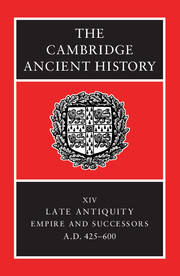Book contents
- Frontmatter
- PART I CHRONOLOGICAL OVERVIEW
- PART II GOVERNMENT AND INSTITUTIONS
- PART III EAST AND WEST: ECONOMY AND SOCIETY
- PART IV THE PROVINCES AND THE NON-ROMAN WORLD
- 18 The north-western provinces
- 19 Italy, A.D. 425–605
- 20 Vandal and Byzantine Africa
- 21a Asia Minor and Cyprus
- 21b Syria, Palestine and Mesopotamia
- 21c Egypt
- 22a The Sasanid monarchy
- 22b Armenia in the fifth and sixth century
- 22c The Arabs
- 23 The Balkans and Greece 420–602
- PART V RELIGION AND CULTURE
- Conclusion
- Chronological Table
- BIBLIOGRAPHY
- Index
- References
20 - Vandal and Byzantine Africa
from PART IV - THE PROVINCES AND THE NON-ROMAN WORLD
Published online by Cambridge University Press: 28 March 2008
- Frontmatter
- PART I CHRONOLOGICAL OVERVIEW
- PART II GOVERNMENT AND INSTITUTIONS
- PART III EAST AND WEST: ECONOMY AND SOCIETY
- PART IV THE PROVINCES AND THE NON-ROMAN WORLD
- 18 The north-western provinces
- 19 Italy, A.D. 425–605
- 20 Vandal and Byzantine Africa
- 21a Asia Minor and Cyprus
- 21b Syria, Palestine and Mesopotamia
- 21c Egypt
- 22a The Sasanid monarchy
- 22b Armenia in the fifth and sixth century
- 22c The Arabs
- 23 The Balkans and Greece 420–602
- PART V RELIGION AND CULTURE
- Conclusion
- Chronological Table
- BIBLIOGRAPHY
- Index
- References
Summary
The period from a.d. 425 to the eve of Islam was a momentous one for North Africa. At its start, what is now seen to have been one of the most prosperous and urbanized of Roman provinces, even if that development came somewhat later than elsewhere, passed without real struggle into Vandal control. The monarchy then established lasted until a.d. 533/4, when a Byzantine force under Belisarius re-established Roman rule, again with surprising speed. The new province established by Justinian’s Pragmatic Sanction of 534 endured in theory, if not fully in reality, until the fall of Carthage itself to the Arabs in a.d. 698; even though Arab armies had defeated and killed a Byzantine exarch in 646–7 and founded an Islamic city at Kairouan in 662, ties between the province and Constantinople were not entirely broken.
These changes of fortune also implied political, religious and economic changes which have been the subject of much recent discussion. The main stimulus for this re-examination has come from archaeology – first and foremost the important series of excavations conducted by a number of national teams at Carthage during the 1970s under the general auspices of UNESCO; these have provided, in many cases for the first time, reliable information at least about parts of the city and its development during this and other periods, and have stimulated and made possible further important developments in such disciplines as the study of ceramics. In turn, the results of these excavations, even though not all are yet fully published, have contributed to the re-examination of issues such as long-distance trade and its place in the Mediterranean economy in the sixth and seventh century.
- Type
- Chapter
- Information
- The Cambridge Ancient History , pp. 552 - 569Publisher: Cambridge University PressPrint publication year: 2001
References
- 3
- Cited by



